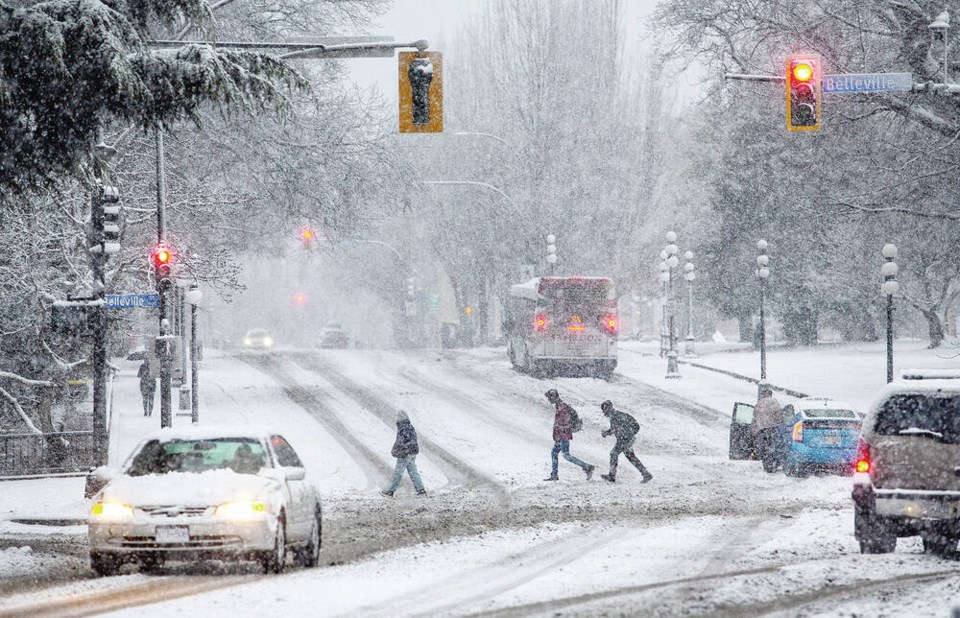If you’ve driven even for a couple of winter seasons, you most certainly have witnessed motor vehicle crashes, near misses or their aftereffects on the road. Many of us will have driven past winter wonderland moments and thought: “How could that have possibly happened?”
For drivers there are mistakes; then there are winter mistakes. Engineers and road-safety experts look at the factors causing collisions regularly, so here is a list of some of the worst, yet all too common, driving mistakes drivers commit over and over again during the dark of winter.
Once again we have the root of all winter motoring errors — driving too fast for road and weather conditions.
During the height of last week’s big storm, I was on a bus heading home from Nanaimo. The road was saturated and deep pools were everywhere. But no matter what the conditions, you can always count on that one driver to have the mind on “Ignore.” This one blew by us at 25 to 30 km/h over the limit, water spraying from behind like the vapour trail from a jet.
There’s absolutely no chance for this person to stop quickly at that speed, emergency or not. Ice, slush and snow simply magnify the problem. It isn’t really a surprise for me anymore when I saw that the car bore an “N” decal.
However, driving too slowly can be a serious problem as well. Crawling along at 10 or 15 km/h on a busy winter road can catch other drivers unaware. With reduced visibility and reaction times, they may not have time to brake or manoeuvre to avoid you. In heavy traffic, slow driving increases the “accordion effect” on those caught behind you, requiring uneven braking and acceleration — stuff you really want to avoid on slippery roads. Ten or even 15 km/h below the limit is acceptable on poor winter roads. Crawling at 8 or 10 km/h can be dangerous.
Next up is failing to equip with snow tires. It’s easy for many drivers around southern Vancouver Island to try to ignore the white stuff for the few weeks that it’s actually around here by simply not bothering to drive. But for the majority, driving in snow is a necessity. To handle snowy roads you need proper winter tires — tires that are actually designed and marked as being snow capable. All season tires won’t cut it.
Snow tires with their deep treads are designed to cut through most snowbound road conditions. They are made of softer compounds allowing them to grip better than harder material found in summer tires. While hard packed icy roads will challenge any type of tire, having good traction in most circumstances is the key to navigating winter roads. Yes, snow tires are expensive, but so is a collision claim.
Being able to see where you are going is also not a bad idea at the best of times, but during the winter when visibility is restricted, having clear windows is essential. Cutting a narrow vision slit through a crust of snow or forgetting about clearing off your side windows isn’t good enough. sa国际传媒 law requires that you have clear vision for the job at hand. While you’re at it, it’s also a good idea to remove that iceberg from your roof before heading out. Numerous incidents, sometimes serious ones, have occurred when chunks of unremoved snow fly off a vehicle striking other cars.
Winter driving puts much more stress on the mechanical components of your vehicle. It’s important then to ensure that your car is fit to drive in icy, cold and wet conditions. All fluids should be topped up to a winter standard and perhaps most importantly the battery should be checked that it’s working to full capacity. Equipment breakdowns during winter months keep towing and rescue services hopping. You could be stranded for hours before help arrives. “Pay me now or pay me later,” as the old winter car care commercials used to say.
Thinking about being stranded is also an important point. Do you have a decent coat and winter shoes with you? How about a flashlight? Leave a spare pair of gloves in your vehicle for the whole winter. Even the simplest of tasks can become agony for fingers exposed to stiff winter winds.
Finally, many drivers are following way too close on winter roads. Double your following distance. Scan the road ahead and not just the car in front. Think in terms of always having an escape route and brake firmly but gently while steering around a problem.
The proper winter mindset of thinking ahead and avoiding these types of mistakes should allow you to beat Old Man Winter.



